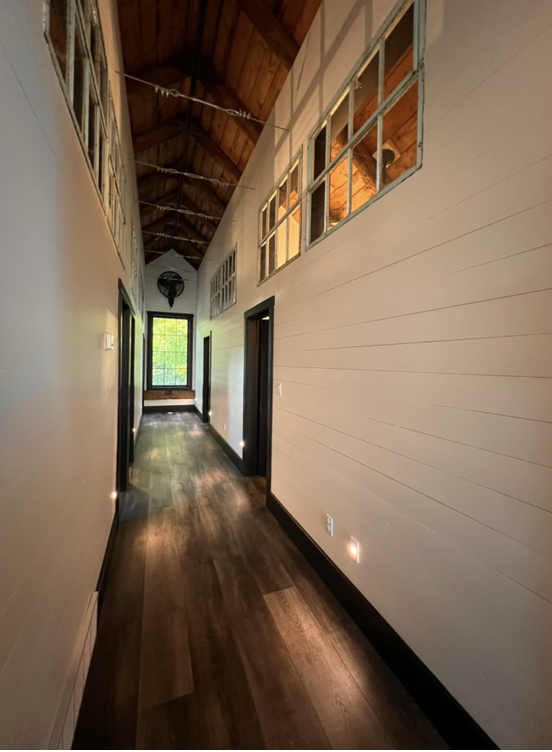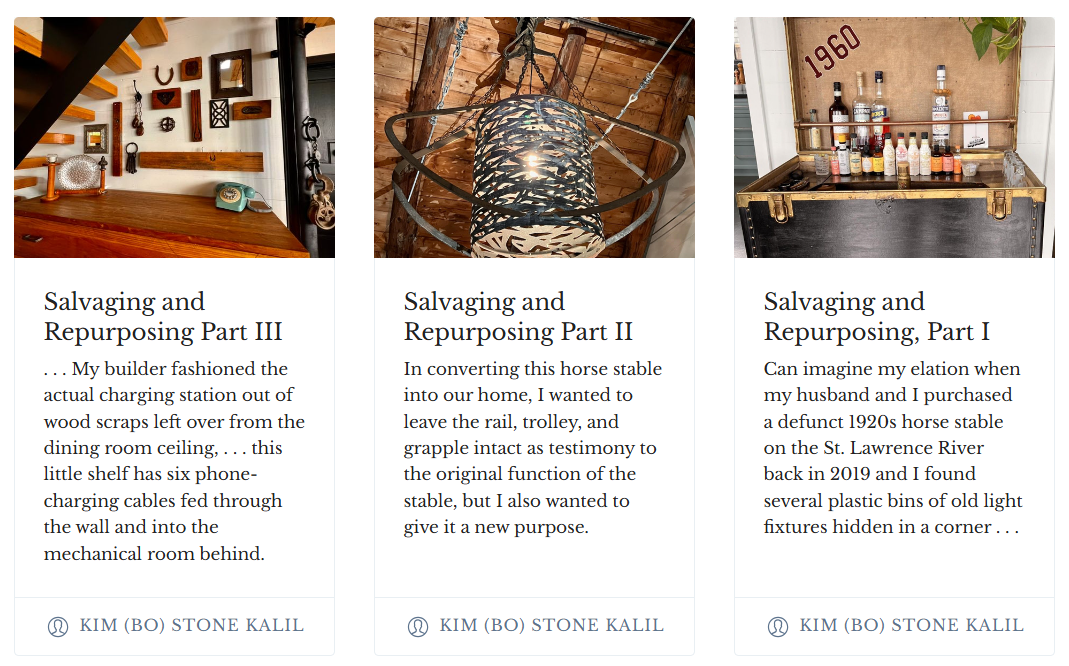Salvaging and Repurposing Part IV
by: Kim (Bo) Stone Kalil
Editor's Note: For the past four months Kim (Bo) Stone Kalil has shared her passion - continuity in design - which has resulted in sharing her many ways to salvage and repurpose items that were not sent to the landfill. She has done this in remodeling her home on the St. Lawrence River in the Thousand Islands - which began life as a 1920s horse stable. This, her fourth article, will make those of us do the proverbial head smacking and say, "why did I not think of that!" Kim did, and she is sharing her sense of design with us.

Main Barn's Second Floor Hallway
As touched upon in last month’s article, the desire to create a connection between the barn dwelling and the outside surrounding elements was accomplished by choosing floor-to-ceiling windows as the predominant material for the vestibule walls. It was a simple way to intermix exterior elements upon entry into the interior space. This mingling of inner and outer spaces creates a feeling of coherence between them, versus a feeling of disconnection. Physical doorways to the exterior then function as mere benign thresholds, as opposed to rigid passageways or borders between the exterior natural world and the built one. This is another instance of the continuity in design that we talked about last month as well.

Several elements were used to achieve a dialogue between these worlds; predominantly colour and materials. The palette and natural variation of colours in the flagstone leading up to the front entrance of the dwelling continues in the visible aggregate of the concrete flooring that flows beautifully throughout the main floor of the barn. This marriage of the exterior ground and the interior floor literally anchors the dwelling in its natural environment and establishes a canvas with which to continue this theme with structural and décor elements.
One of these décor elements was the brilliant idea of my son Matthew, an artist and designer who studied architecture. He suggested using the original exterior windows as interior transoms in the barn’s second floor hallway, to allow light into the bedrooms and my studio. These rooms are enveloped by the barn’s huge pitched roof, rather than by vertical exterior walls, and adding in too many skylight windows would either disrupt the beauty of the original 1920s roof structure, or even necessitate replacing it. While we needed to replace the exterior cladding of the roof anyway, we were adamant about preserving its wooden structure. So, we added just a few skylights to several of the rooms, and by incorporating the original exterior windows as transoms, additional natural light was allowed into the interior of the rooms from the hallway, while also adding visual interest to the hallway walls.

The first time I walked through the defunct horse stable, I noticed these beautifully patinaed metal framed and mullioned windows. With several layers of chipped and peeling paint colours, they reflected a long, rich and weathered life on the River’s bank. I had originally wanted to hang them in panel form in the front of the vestibule’s south plate glass window in order that their form and patina may be enjoyed from both the outside patio and the inside vestibule area, But Matthew’s idea offered a wonderful way to preserve them and spare them potential damage in a high traffic area, while providing them a functional purpose as well.
After incorporating this design decision, I had to address how to light the hallway during the evening hours when it was dark. I didn’t want to use ceiling fixtures or wall sconces, as these would shine into the bedrooms, so I used exterior LED landscape path lights, staggered down the hallway about five inches above the floor. These provide the light necessary for people to see where they are walking and guide them to their respective rooms without causing intrusive brightness in the rooms themselves.
Exterior Mechanical Yard
The design and orientation of the new volume housing the garage and apartment, along with the vestibule that connects this volume to the main barn volume, created a triangular exterior area to the left of our front entryway.
This is where mechanical equipment such as the A/C, generator, propane tanks, and so on, are situated. Mechanical equipment and machines have certainly had their beautiful moments in history. Great consideration has often been given to using their functional forms as opportunities for ornament or expression with an aesthetically pleasing appearance, eliciting a positive human response. One of these was the Art Deco movement, at the height of which time the original horse stable was built. Evidence of this design is in the three large metal roof vents, which we carefully removed and then reinstalled after the new roof cladding had been put in place.

Sadly, today most mechanical equipment is devoid of a pleasant aesthetic and is indeed quite unsightly, as is the case with the contemporary mechanical elements serving the barn. In order to hide the equipment, I repurposed a pair of the original interior barn stall doors as an entry gate to the mechanical yard, and flanked them with cedars, whose tips seem to mimic those of the roof vents.

I had the stall doors painted the same Waller Green as the barn’s exterior walls, with their support poles and hardware painted black to provide continuity with the rest of the barn’s windows, doors, etc. These doors provide a beautiful aesthetic amidst the greenery and gardens, while hiding the visually jarring machines.
There’s an elegant unity at work here, created by the vertical lines in the stall doors’ upper barred sections, the board and batten cladding of the exterior walls, and that of the ribs of the metal roofing. As well, the peaks of the roof vents and cedar rows pointing skyward, and the Waller Green exterior paint colour with its earthy undertones, an extension of the colour palette of the gardens. All of these design choices here have afforded a pleasant visual rhythm in an area that could have otherwise been quite displeasing.
I have described my continuity in design in this series of four articles on Salvaging and Repurposing. As I have written at the end of each, "By all means, let me know if you have a special item that you have salvaged and not sent to the landfill."
By Kim (Bo) Stone Kalil
Kim (nicknamed Bo in high school) Stone Kalil, lives in Toronto and spends as much time as possible with her family and friends at her home in the Thousand Islands, which was previously a 100-year-old defunct horse stable. Her design company is kskdesign.ca and she designed the home with the help of architectural designer Michael Preston out of Kingston, and had many design conversations with her son Matthew Kalil a Master of Architecture graduate of University of Toronto. The extensive renovation was done during 2020-2023 by the incredible Brian Wooding from Gananoque and his talented team. Bo is an avid traveller, photographer and dabbles in acrylic painting. As if that does not keep her busy enough, Bo is pursuing a degree in psychology part-time at York University in Toronto.







Please click here if you are unable to post your comment.